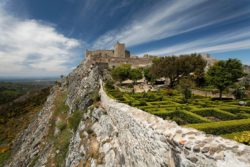
The use of the rocks of Marvão as a refuge for villages devastated by invading peoples, as a watchtower or as a strategic point in strictly military terms, will date, at least, from the Roman period. We can refer to the following fully documented historical facts:
Roman and High Middle Ages
If in the century. X, what today is Marvão, was identified by the Cordovan historian Isa Ibn Áhmad ar-Rázi, by Fortaleza de Amaia and by Fortaleza de Amaia-o-Monte, among other designations, this raises the hypothesis that there would be a fortification at the top of the hill that would have served the city of Ammaia, founded in the century. I, during its existence.
Arab Period – 19th century. IX
In the century. X, Marvão was identified, by the aforementioned Cordovan historian and in addition to the designations already mentioned, by Monte de Amaia and by Amaia de Ibn Maruán. Ibn Maruán, from his full name ‘Abd ar-Rah.ma:n Ibn Marwa: n Ibn Yu: nus al-Jillí: qi (Ab-spill son of Marvão son of Iúnece – ie Johannes-João – Galician), was a muladi of noble emeritense strain that was celebrated in the last quarter of the century. IX as a rebel and warlord against the Emirate
of Cordoba. The Ammaia Fortress then served as a strategic refuge for the (re) founder of Badajoz when, in this capital, he felt threatened. So it was in the year 884 when the troops of the Emir Muhâmmad approached, threatening to destroy the city and flee to their Mount: Marvão.
Reconquest Period – 1160/1166
In his campaign of 1160/1166, the first king of Portugal, D. Afonso Henriques, will have conquered Marvão, although it is not known if definitely, taking into account the counter-offensive of Almansor, between 1190/1191, up to the Tagus line .
Charter of 1226
In 1226, D. Sancho II attributed to Marvão his first charter, one of the first royal charters in Alentejo.
D. Dinis takes over Marvão
The strategic importance of Marvão – and other Castles of the Streak – led D. Dinis to dispute it with his brother D. Afonso, in 1299, taking possession of the fortification.
Crisis of 1383-1385
Taking over the Castle by party forces of Mestre de Avis, being mayor Fr. Pedro Álvaro Pereira, Prior do Crato, frontier of Alentejo and mayor of Portalegre, after a close fight that lasted half a day.
War of the Restoration, 1641-1668
From the restoration of independence, the old medieval fortification was rehabilitated in the face of new war technologies, remaining bastioned in sensitive areas and the Castle becoming its citadel. During the war it plays an important role in the defense of Alto Alentejo. There were two major attacks on the fortress: in 1641 and 1648, the latter under the command of the Marquis of Lagañes.
War of the Succession of Spain, 1704-1712
After the fall of Castelo de Vide, on June 24, 1704, Praça de Marvão was surrendered without a battle. Later, having the population, the French governor of the paisanos ordered to arrest the population, to hang, for example, some popular ones, and to send others under arrest to Castile, including the friars of the Convent of Nossa Senhora da Estrela. The square was subsequently taken over by the Portuguese army commanded by the Count of São João. In front of the Bulwark of Portas da Vila, the attack by the Portuguese infantry commanded by the Count of Coculim was distinguished.
Seven Years’ War, 1756-1762
In November 1762, Marvão suffered a surprise attack from the Spanish army during the last operations.
Testimony to the strategic importance of the Square, 1796
Lieutenant Colonel Engenheiro, Tomás de Vila Nova and Sequeira: His position on the Fronteira line makes him important for his defense, because from Valencia de Alcântara or Albuquerque to Portalegre, to Crato, to Castelo de Vide and also to Ribatejo , there is no other road where artillery can be driven than that of Porto da Espada, which is visible in front of the square in what they call the Prado, and it is also possible to take artillery against the same square.
War of Oranges, 1801
Praça de Marvão suffers several attacks, always resisting.
Peninsular Wars, 1807-1811
On the 25th of June 1808, the square, ruled by the French, suffered a victorious assault by a corps of Valencian volunteers (Valencia de Alcântara) led by D. Mateus Monge. The Spaniards were instigated by the fearless clerk of the general of the village (or Juís de Fora?) Of Marvão, Joaquim António da Cruz, who had taken refuge in Spain after his unsuccessful attempt to uphold the population. The assault was commanded by Spanish Lieutenant-Colonel D. Vicente Perez and by Lieutenant-Colonel graduated from militias, D. Pedro de Magalhães, son of Portuguese architect Teodoro Magalhães.
Liberal Wars, 1832-1834
In June / July 1833, Praça de Marvão, commanded by the Miguelista Colonel Francisco da Silva Lobo, resists the surrender summonses made by the constitutional guerrilla, in turn commanded by the former colonel of the Spanish army, D. Manuel Martini. In this period